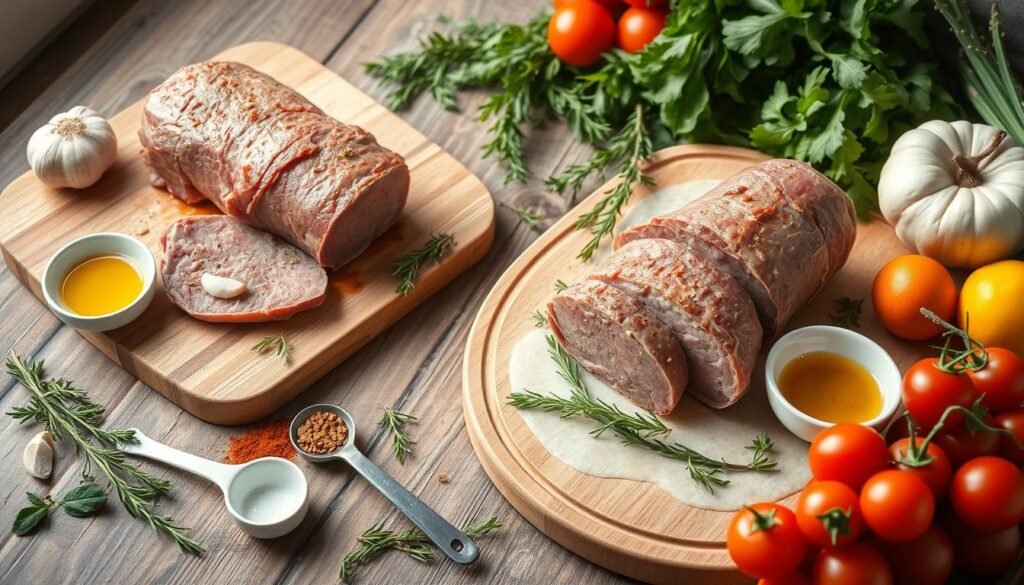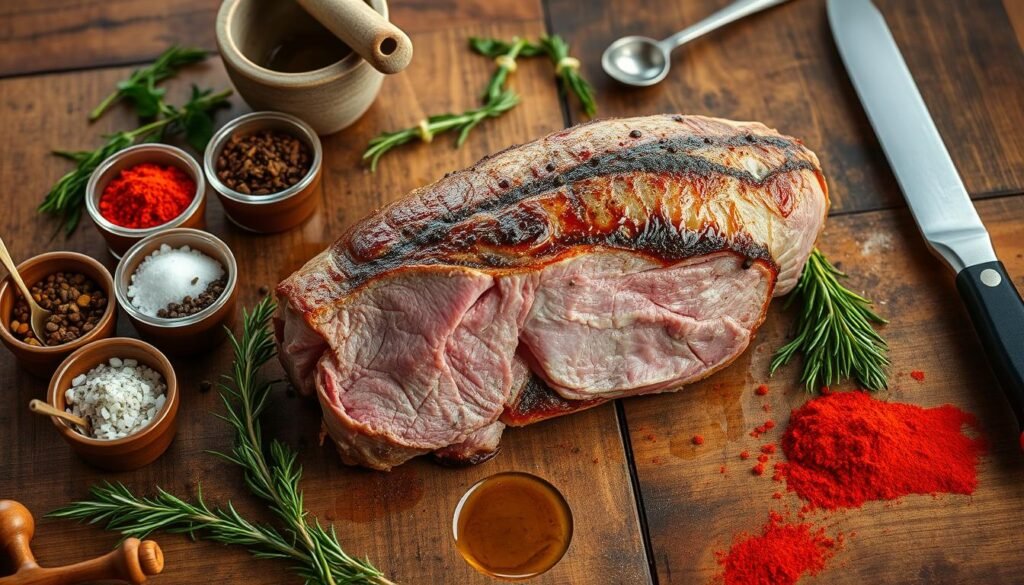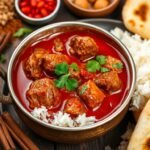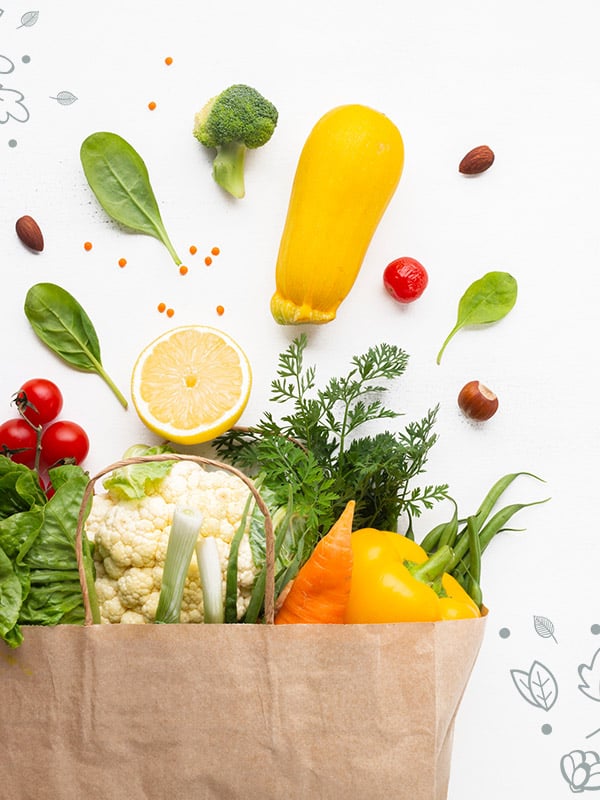A tender lamb loin roast is a timeless favorite in lamb recipes. It’s a dish that impresses everyone. With the right ingredients and techniques, you can make a delicious meal that wows your guests.
Table of Contents
This recipe is perfect for both seasoned chefs and beginners. It will take your dinner to the next level. We’ll cover everything from the basics of lamb loin roast to mastering roast cooking techniques. Let’s start this culinary adventure together.
Key Takeaways
- Understanding the basics of lamb loin roast is crucial for a delicious dish
- Roast cooking requires attention to detail and the right techniques
- Lamb recipes can be elevated with the right ingredients and equipment
- A tender lamb loin roast is a classic choice for special occasions
- Mastering the art of roast cooking takes practice and patience
- With this guide, you’ll be well on your way to creating a mouthwatering lamb loin roast
Understanding the Perfect Lamb Loin Roast
Cooking a delicious lamb loin roast is all about understanding its special qualities. You’re probably looking for a tender and flavorful dish that’s also good for you. The lamb loin is lean, packed with protein and nutrients, making it great for those who care about their health.
The secret to a perfect lamb loin roast is its tenderness and taste. A good balance of marbling is key. It makes the meat more flavorful and tender. So, when picking a cut, aim for one with just the right amount of marbling for a juicy roast.
What Makes Lamb Loin Special
Lamb loin is a favorite among meat lovers for good reasons. It’s special because of its high protein, rich nutrients, low fat, and tender texture. These qualities make it a standout choice for a healthy and tasty meal.
Nutritional Benefits of Lamb
Lamb is packed with important nutrients like protein, iron, and zinc. These benefits make it a great option for a healthy and delicious meal. It’s perfect for those who want to enjoy a nutritious dish without sacrificing flavor.
Choosing the Right Cut
Choosing the right lamb loin cut is key to a perfect roast. Look for a cut with the right balance of marbling and tenderness. With the right cut and some cooking skills, you can make a tender and flavorful lamb loin roast that will wow your guests.
| Lamb Loin Cut | Marbling | Tenderness |
|---|---|---|
| Lamb Loin Chop | High | Tender |
| Lamb Loin Roast | Medium | Lean |
| Lamb Loin Steak | Low | Chewy |
Essential Equipment for Your Roast
To cook a perfect lamb loin roast, you need some key tools. A meat thermometer is crucial to check the roast’s internal temperature. You’ll also need a roasting pan that can handle high heat and a sharp knife for cutting the roast.
Don’t forget kitchen twine to tie the roast. It helps it cook evenly and keeps it from falling apart.
Having the right tools is vital for cooking techniques. With a good roasting pan and a meat thermometer, you can get a roast with a crispy outside and a soft inside. You might also want a cutting board for prep, a whisk for marinades, and a spatula for basting.
- A stand mixer for mixing and kneading marinades
- A food processor for chopping herbs and aromatics
- A slow cooker for cooking the roast low and slow
Investing in these tools and learning cooking techniques will help you make a tasty lamb loin roast. It’s sure to impress your loved ones.
The Ultimate Lamb Loin Roast Recipe
To make a tasty lamb loin roast, mix flavorful ingredients with a good seasoning guide. This brings out the lamb’s natural flavors, making it delicious. Start by getting your ingredients, like garlic, rosemary, and lemon, which are key for your seasoning.
For your seasoning guide, you can pick simple salt and pepper or try more complex spice mixes. Here are some ingredients to think about:
- Garlic powder
- Dried rosemary
- Lemon zest
- Black pepper
After picking your seasoning guide, think about marinades. A marinade can make your lamb loin roast even tastier and juicier. You can use a classic herb and lemon mix or something spicier with garlic and chili flakes. Always use a reliable seasoning guide for the best taste.
By using a good seasoning guide and choosing marinades, you’re on your way to the ultimate lamb loin roast. Try different ingredients and seasoning mixes to find the flavor you love.
Preparing Your Lamb Loin
Preparing your lamb loin starts with a good meal planning strategy. You need the right ingredients, tools, and cooking knowledge. Planning ahead helps you avoid last-minute stress and ensures your lamb is cooked just right.
First, trim and clean the lamb loin to remove fat and silver skin. This makes the meat cook evenly and prevents it from getting too greasy. Then, tie the loin with kitchen twine to keep it in shape and cook evenly.
Temperature Guidelines
When cooking your lamb loin, remember the temperature guidelines. For medium-rare, aim for 130°F to 135°F. For medium, it’s 140°F to 145°F. A meat thermometer helps you get the perfect temperature.

Tying Techniques
There are many ways to tie your lamb loin. You can use a simple knot or a more complex twine pattern. Just make sure the twine is tight enough to hold the meat but not too tight.
By following these steps and planning your meal, you’ll make a delicious lamb loin dish. It’s sure to impress your loved ones.
| Internal Temperature | Level of Doneness |
|---|---|
| 130°F – 135°F | Medium-rare |
| 140°F – 145°F | Medium |
| 150°F – 155°F | Medium-well |
| 160°F – 165°F | Well-done |
Perfect Cooking Techniques
To cook perfectly, knowing about temperature and time is key. When cooking a lamb loin roast, aim for an internal temperature of at least 145°F (63°C). This ensures safety and flavor. Let it rest for three minutes before serving.
But temperature is just part of the story. The technique you use also matters. You can roast, grill, or pan-fry a lamb loin roast. Each method needs attention and practice to get it right. For example, roasting requires a meat thermometer, while grilling needs care to avoid burns.
- Using a meat thermometer to ensure the internal temperature is reached
- Not overcrowding the pan or oven, as this can affect cooking time and temperature
- Letting the meat rest for a few minutes before serving, allowing the juices to redistribute
Follow these tips and practice your technique to cook perfectly. Perfect cooking balances temperature, time, and method. With patience and practice, you’ll make a delicious lamb loin roast that will wow everyone.
| Cooking Method | Internal Temperature | Rest Time |
|---|---|---|
| Roasting | 145°F (63°C) | 3 minutes |
| Grilling | 145°F (63°C) | 3 minutes |
| Pan-frying | 145°F (63°C) | 3 minutes |
Seasoning Secrets for Maximum Flavor
To get the most out of your lamb loin roast, mastering seasoning is key. The right seasoning can make your dish unforgettable. It’s all about finding the perfect mix of flavors that enhance the lamb’s natural taste.
Herb combinations are a great way to add depth to your lamb loin roast. Fresh herbs like rosemary, thyme, and parsley can be mixed to create unique flavors. For instance, rosemary and thyme together make a classic mix that goes well with lamb.
Exploring Spice Blends
Spice blends are also crucial for seasoning. Aromatic spices like cumin, coriander, and paprika bring a warm, earthy taste. You can try different blends, like garlic powder, onion powder, and black pepper, for a savory flavor.

Garlic and Aromatics
Garlic and aromatics are essential for seasoning. Sauteed garlic and onions add a rich, savory taste. Aromatics like carrots and celery add a fresh crunch. These ingredients make your dish unforgettable.
Monitoring Cooking Progress
As you cook your lamb loin roast, it’s key to watch its progress. You need to check the internal temperature and let the meat rest. This ensures a tender, juicy, and flavorful roast.
Knowing how your meat is cooking is very important. It affects the taste and texture of your dish. Use a meat thermometer to ensure the meat is cooked safely.
Internal Temperature Guide
The internal temperature guide helps you monitor your cooking. For lamb, it should be at least 145°F (63°C) with a 3-minute rest. Here’s a temperature guide to follow:
- Medium-rare: 130°F – 135°F (54°C – 57°C)
- Medium: 140°F – 145°F (60°C – 63°C)
- Medium-well: 150°F – 155°F (66°C – 68°C)
- Well-done: 160°F – 170°F (71°C – 77°C)
Resting Time Importance
After taking the lamb out of the oven, let it rest. This makes the meat tender and flavorful. The rest time depends on the roast’s size, but 10-15 minutes is a good rule.
By keeping an eye on your cooking and using the temperature guide, you’ll get a perfectly cooked lamb loin roast. Always let the meat rest as recommended for the best results.
| Cooking Method | Internal Temperature | Resting Time |
|---|---|---|
| Oven Roasting | 145°F (63°C) | 10-15 minutes |
| Grilling | 130°F – 135°F (54°C – 57°C) | 5-10 minutes |
| Pan-Searing | 140°F – 145°F (60°C – 63°C) | 5-10 minutes |
Serving Suggestions and Pairings
There are many ways to serve your lamb loin roast. Try it with roasted vegetables like Brussels sprouts or carrots for color and taste. Or, pair it with mashed potatoes or a fresh salad for something lighter.
For additional flavor, try different sauces and gravies. Mint sauce or demiglace are great choices. You can also add roasted garlic and herbs like rosemary or thyme to enhance the lamb’s flavor.
Here are some serving suggestions to consider:
- Roasted vegetables, such as Brussels sprouts or carrots
- Mashed potatoes or a fresh salad
- Classic mint sauce or a rich demiglace
- Roasted garlic and herbs, such as rosemary or thyme
Finding the right balance of flavors and textures is key. Experiment with different combinations to make a dish that’s both tasty and memorable.
By using these serving suggestions, you can elevate your lamb loin roast. A bit of creativity can help you find the perfect mix of flavors and textures that you’ll love.
Storing and Reheating Tips
Storing food, especially leftovers, is key to keeping it fresh and tasty. You should use the right storage methods to keep your lamb loin roast fresh longer. Wrap the meat tightly in plastic wrap or aluminum foil for easy storage in the fridge or freezer.
For the best results, store the lamb loin roast in an airtight container. This keeps it fresh and ready for reheating. When reheating, use low heat and add a bit of liquid to prevent drying out the meat.
Proper Storage Methods
- Wrap the meat tightly in plastic wrap or aluminum foil
- Store in an airtight container
- Keep in the refrigerator or freezer at a consistent temperature
Reheating Without Drying
To reheat your lamb loin roast without drying it out, follow these steps:
- Preheat your oven to a low temperature (around 300°F)
- Place the lamb loin roast in a pan with a bit of liquid (such as broth or wine)
- Cover the pan with aluminum foil to retain moisture
- Reheat for 10-15 minutes, or until the meat reaches your desired temperature
By using these storing and reheating tips, you can enjoy your lamb loin roast for longer. It will stay flavorful and fresh.
| Storage Method | Temperature | Shelf Life |
|---|---|---|
| Refrigerator | 39°F (4°C) | 3-5 days |
| Freezer | 0°F (-18°C) | 6-8 months |
Troubleshooting Common Issues
Cooking a lamb loin roast can sometimes go wrong, even with a great recipe. Knowing how to fix common problems is key to a perfect dish. Troubleshooting can be tough, but with the right steps, you can avoid or solve issues like overcooking, seasoning problems, and texture issues.
One big problem is overcooking. To avoid this, keep an eye on the lamb’s internal temperature. A meat thermometer helps ensure it reaches the right temperature. Seasoning issues can also pop up. To fix this, you can tweak the seasoning or add new herbs and spices to boost the flavor.
Preventing Overcooking
To stop overcooking, try these tips:
- Use a meat thermometer to check the internal temperature
- Don’t overcrowd the roasting pan
- Use a lower oven temperature
Fixing Seasoning Problems
To solve seasoning issues, try these:
- Adjust the amount of seasoning
- Add different herbs and spices
- Marinate the lamb loin roast before cooking
Texture Solutions
For the perfect texture, try these:
| Texture Issue | Solution |
|---|---|
| Overly dry | Use a meat mallet to tenderize the lamb loin roast |
| Undercooked | Cook the lamb loin roast for a few more minutes |
By using these tips and troubleshooting common issues, your lamb loin roast will always be perfect. Always watch the cooking process and adjust as needed for the best results.
Conclusion
Preparing a tender and flavorful lamb loin roast needs focus, the right tools, and practice. By following the tips in this article, you’ll make a dish that will wow your guests. Don’t forget to try different seasonings, keep an eye on the cooking, and store leftovers right to keep them fresh.
Whether you’re an experienced cook or just starting, mastering lamb loin roast opens up new culinary adventures. Enjoy the tender meat and the praise from your loved ones. This guide gives you the skills to make your lamb loin roast stand out, both in looks and taste.
Next time you want a delicious main dish, try making the perfect lamb loin roast. Experiment with seasonings and marinades to find your favorite. Happy cooking!
FAQ
What makes lamb loin special?
Lamb loin is tender and lean, packed with protein and nutrients. It’s low in fat, making it great for those watching their diet.
What are the nutritional benefits of lamb?
Lamb is full of vitamins and minerals like vitamin B12, iron, and zinc. It also has healthy fats, including omega-3s.
How do I choose the right cut of lamb loin?
Look for a cut with some marbling. This adds flavor and tenderness to the meat.
What essential equipment do I need for a lamb loin roast?
You’ll need a meat thermometer, roasting pan, sharp knife, and kitchen twine. These tools help you cook and present the roast perfectly.
What are the key steps for trimming and preparing the lamb loin?
Start by trimming and cleaning the meat. Then, tie it with twine for even cooking.
How do I achieve the perfect cooking temperature and technique for lamb loin?
Cook the roast at the right temperature and for the right time. Let it rest to keep the juices in.
What are some seasoning secrets for maximum flavor in a lamb loin roast?
Use herbs, spice blends, and aromatic ingredients like garlic. Try different combinations to find your favorite flavor.
How do I monitor the cooking progress of my lamb loin roast?
Use a meat thermometer to check the temperature. Let it rest before serving to keep it juicy.
What are some serving suggestions and pairings for a lamb loin roast?
Serve with roasted veggies, mashed potatoes, or a fresh salad. Try different sauces for extra flavor.
How do I properly store and reheat leftover lamb loin roast?
Wrap it tightly in plastic or foil to store. Reheat low and slow, adding liquid to keep it moist.
How can I troubleshoot common issues with lamb loin roast, such as overcooking or seasoning problems?
To fix common issues, prevent overcooking and adjust seasoning. Understanding these problems helps ensure a perfect roast every time.



